Related Research Articles

A cerebral arteriovenous malformation is an abnormal connection between the arteries and veins in the brain—specifically, an arteriovenous malformation in the cerebrum.

An intracranial aneurysm, also known as a cerebral aneurysm, is a cerebrovascular disorder in which weakness in the wall of a cerebral artery or vein causes a localized dilation or ballooning of the blood vessel.
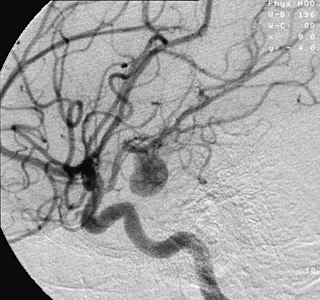
An aneurysm is an outward bulging, likened to a bubble or balloon, caused by a localized, abnormal, weak spot on a blood vessel wall. Aneurysms may be a result of a hereditary condition or an acquired disease. Aneurysms can also be a nidus for clot formation (thrombosis) and embolization. As an aneurysm increases in size, the risk of rupture, which leads to uncontrolled bleeding, increases. Although they may occur in any blood vessel, particularly lethal examples include aneurysms of the Circle of Willis in the brain, aortic aneurysms affecting the thoracic aorta, and abdominal aortic aneurysms. Aneurysms can arise in the heart itself following a heart attack, including both ventricular and atrial septal aneurysms. There are congenital atrial septal aneurysms, a rare heart defect.

Cerebral angiography is a form of angiography which provides images of blood vessels in and around the brain, thereby allowing detection of abnormalities such as arteriovenous malformations and aneurysms. It was pioneered in 1927 by the Portuguese neurologist Egas Moniz at the University of Lisbon, who also helped develop thorotrast for use in the procedure.

Loeys–Dietz syndrome (LDS) is an autosomal dominant genetic connective tissue disorder. It has features similar to Marfan syndrome and Ehlers–Danlos syndrome. The disorder is marked by aneurysms in the aorta, often in children, and the aorta may also undergo sudden dissection in the weakened layers of the wall of the aorta. Aneurysms and dissections also can occur in arteries other than the aorta. Because aneurysms in children tend to rupture early, children are at greater risk for dying if the syndrome is not identified. Surgery to repair aortic aneurysms is essential for treatment.

Neurocritical care is a medical field that treats life-threatening diseases of the nervous system and identifies, prevents, and treats secondary brain injury.

A cerebrospinal fluid leak is a medical condition where the cerebrospinal fluid (CSF) surrounding the brain or spinal cord leaks out of one or more holes or tears in the dura mater. A cerebrospinal fluid leak can be either cranial or spinal, and these are two different disorders. A spinal CSF leak can be caused by one or more meningeal diverticula or CSF-venous fistulas not associated with an epidural leak.

Familial aortic dissection or FAD refers to the splitting of the wall of the aorta in either the arch, ascending or descending portions. FAD is thought to be passed down as an autosomal dominant disease and once inherited will result in dissection of the aorta, and dissecting aneurysm of the aorta, or rarely aortic or arterial dilation at a young age. Dissection refers to the actual tearing open of the aorta. However, the exact gene(s) involved has not yet been identified. It can occur in the absence of clinical features of Marfan syndrome and of systemic hypertension. Over time this weakness, along with systolic pressure, results in a tear in the aortic intima layer thus allowing blood to enter between the layers of tissue and cause further tearing. Eventually complete rupture of the aorta occurs and the pleural cavity fills with blood. Warning signs include chest pain, ischemia, and hemorrhaging in the chest cavity. This condition, unless found and treated early, usually results in death. Immediate surgery is the best treatment in most cases. FAD is not to be confused with PAU and IMH, both of which present in ways similar to that of familial aortic dissection.
Joshua B. Bederson is an American neurosurgeon, Leonard I. Malis, MD/Corinne and Joseph Graber Professor of Neurosurgery, and Chair of Neurosurgery at the Mount Sinai Health System in New York City. He is a Fellow of the American College of Surgeons and an attending neurosurgeon at The Mount Sinai Hospital and Elmhurst Hospital in Elmhurst, Queens.

Robert F. Spetzler is a neurosurgeon and the J.N. Harber Chairman Emeritus of Neurological Surgery and director emeritus of the Barrow Neurological Institute in Phoenix, Arizona. He retired as an active neurosurgeon in July 2017. He is also Professor of Surgery, Section of Neurosurgery, at the University of Arizona College of Medicine in Tucson, Arizona.
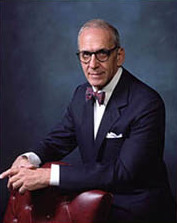
James Ivan Ausman is an American neurosurgeon, science editor, television broadcaster, medical entrepreneur, and public advocate on health-care reform. He currently is professor of neurosurgery at the University of California, Los Angeles and editor-in-chief of Surgical Neurology International.
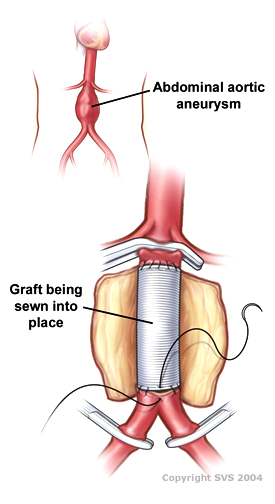
Open aortic surgery (OAS), also known as open aortic repair (OAR), describes a technique whereby an abdominal, thoracic or retroperitoneal surgical incision is used to visualize and control the aorta for purposes of treatment, usually by the replacement of the affected segment with a prosthetic graft. OAS is used to treat aneurysms of the abdominal and thoracic aorta, aortic dissection, acute aortic syndrome, and aortic ruptures. Aortobifemoral bypass is also used to treat atherosclerotic disease of the abdominal aorta below the level of the renal arteries. In 2003, OAS was surpassed by endovascular aneurysm repair (EVAR) as the most common technique for repairing abdominal aortic aneurysms in the United States.
The Dextroscope is a medical equipment system that creates a virtual reality (VR) environment in which surgeons can plan neurosurgical and other surgical procedures.
Yoko Kato is a Japanese neurosurgeon. She is professor and chair of the Department of Neurosurgery at Fujita Health University. She was the first woman in Japan to be promoted to full professor of neurosurgery.

William T. Couldwell M.D., Ph.D., a neurosurgeon, was born in British Columbia, Canada. He is Professor and Chairman of the Department of Neurosurgery at the University of Utah, a position he assumed in 2001.
Multisystemic smooth muscle dysfunction syndrome (MSMDS) is a genetic disorder caused by R179 missense mutations in the ACTA2 gene. Initially described as a case report in 1999, it was characterized in 2010 as a syndrome of congenital mydriasis, patent ductus arteriosus, and aneurysmal arterial disease—in particular aortic and thoracic aneurysms. The disorder has variable penetrance, ranging from severely symptomatic and fatal in early neonatal period to a more benign and manageable course with surgical intervention.
Alexander Coon, M.D. is an American neurosurgeon and the Director of Endovascular and Cerebrovascular Neurosurgery at the Carondelet Neurological Institute of St. Joseph's and St. Mary's Hospitals in Tucson, Arizona. He was previously the Director of Endovascular Neurosurgery at the Johns Hopkins Hospital and an Assistant Professor of Neurosurgery, Neurology, and Radiology at the Johns Hopkins Hospital. He is known for his work in cerebrovascular and endovascular neurosurgery and his research in neuroendovascular devices and clinical outcomes in the treatment of cerebral aneurysms, subarachnoid hemorrhage, and AVMs.
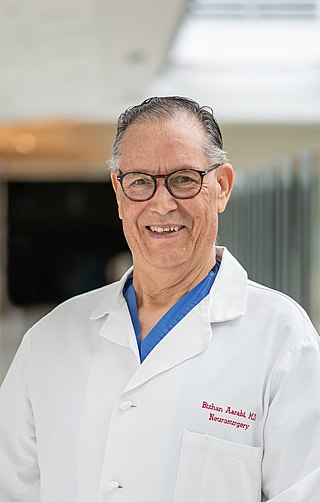
Bizhan Aarabi is an Iranian-American neurosurgeon, researcher, author, and academic. He is a Professor of Neurosurgery at University of Maryland and the Director of Neurotrauma at the R Adams Cowley Shock Trauma Center.

Hazim J. Safi, MD, FACS, is a physician and surgeon who is well-known for his research in the surgical treatment of aortic disease. Safi and his colleagues at Baylor College of Medicine were the first to identify variables associated with early death and postoperative complications in patients undergoing thoracoabdominal aortic operations. Safi now serves as professor of cardiothoracic surgery, and founding chair at McGovern Medical School at The University of Texas Health Science Center in Houston, TX.
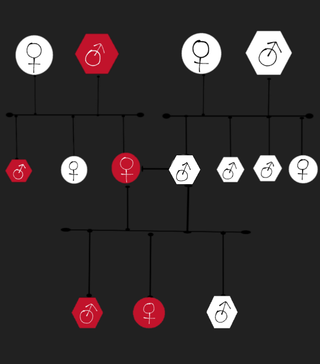
Familial thoracic aortic aneurysm and aortic dissection is a very rare vascular genetic disorder, it's characterized by recurrent thoracic aortic aneurysms and aortic dissections within a family, these mentioned complications affect one or more aortic segments without any other disease being associated with them. People with this disorder have a higher chance of having a potentially fatal aortic rupture. This disorder is the cause of 20% of thoracic aortic aneurysms
References
- ↑ Grady, Denise (March 11, 2011). "Giffords's Personality Emerges in Recovery, Doctors Say". New York Times. Retrieved April 12, 2012.
- ↑ "Dong H. Kim, MD, FAANS". The Society of Neurological Surgeons.
- ↑ Perin, Monica (November 15, 2007). "Houston Institutions Snag Another Harvard Heavyweight". Houston Business Journal.
- ↑ Cohen, Elizabeth (February 2, 2011). "Giffords' Houston Doc: From Outsider to Brain Surgeon". CNN. Retrieved April 12, 2012.
- ↑ "Dong H. Kim Bio". Marquis Who's Who. Archived from the original on 2012-07-13. Retrieved 2012-04-12.